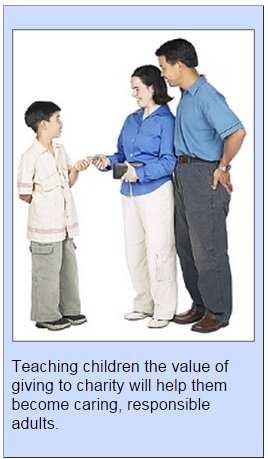The Benefits of Giving to Charity:
What to Teach Children (and Refresh Yourself On)
© 2015 Health Realizations, Inc.
With finances tight for many in the United States, giving to charity may not be at the top of
your list of places your money needs to go. Yet, while giving to charity is always an
optional thing, doing so on a regular basis can have very real benefits for you and your
family.
 Teaching Your Children About Charity
Teaching Your Children About Charity
Why would your children need to know about charity? Well, it's one of the key ways that you can help your children develop into caring, well-rounded people when they get older. And in a world so full of violence and apathy, raising concerned, empathetic children is a necessity for the future.
Children, in fact, are naturally caring. One study found that children as young as 21 months show signs of empathy when their parents are upset (crying or arguing). Another study, this one published in the American Psychological Association's (APA) Developmental Psychology journal, found that even young children who are aggressive and disruptive show "concern for the welfare of others." However, the startling finding is that this concern can decrease as children reach school age.
One of the ways you can help to foster a sense of caring in your child, even as they get older, is by teaching them to help others in the form of giving to charity. According to the American Psychological Association:
"One study by Ziporah Magen, Ph.D. and Rachel Aharoni, Ph.D. found that teenagers who were involved in helping others felt very positive about their lives and had high hopes for their own futures. 'It was a wonderful feeling,’ reported one student in this study. 'My feeling as free as a sparrow made me feel glad and happy and that life is an exciting thing.'
The Benefits of Giving
Children and adults alike can also benefit from the act of giving to charity. "Giving" can, of course, be in the form of a monetary donation or donating items or your time to those in need.
Allan Luks, author of The Healing Power of Doing Good, describes many scientifically documented accounts of people gaining physical, mental and emotional benefits from doing good. For instance, holding an abandoned baby may help get rid of your backache, he says. Luks even describes a "helper's high" that is similar to the high we feel after exercising. And, Luks maintains that volunteering provides:
- A heightened sense of well-being
- Relief from insomnia
- A stronger immune system
- Speedier recovery from surgery
Financial experts recommend "charitable-giving tactics and strategies" as a way to improve your financial portfolio. Rather than giving willy-nilly, this means that you come up with a giving strategy that ultimately allows you to be more generous over time.
Experts recommend planning your charity budget each December by deciding how much you'll give to charity the following year. Decide which preferred charities will get how much, and leave a little unaccounted for in case of emergency relief funds or other spur- of-the-moment donations you'd like to make.
Children, too, can be taught to plan for charitable giving from a young age. Children and teens can devote their time to volunteer work, while giving a limited amount of funds to a preferred charity (with the money coming out of their discretionary funds).
For you adults, keep in mind that only donations to qualified organizations are deductible. These include federal, state and local governments and organizations organized and operated only for:
- Charitable purposes
- Religious purposes
- Educational purposes
- Scientific purposes
- Literary purposes
- Prevention of cruelty to children or animals
 If you are unsure, the organization will be able to tell you whether your donation qualifies
for tax benefits. There are some exceptions and rules to be aware of.
If you are unsure, the organization will be able to tell you whether your donation qualifies
for tax benefits. There are some exceptions and rules to be aware of.
First, if you get merchandise, goods or services from your contribution, you must subtract the fair market value of those items from your deduction. For instance, if you buy a ticket to a charity dinner for $150, and the dinner is worth $60, you can only deduct $90. Also:
- If you donate $250 or more, you must get a written receipt in order to deduct it.
- When claiming property donated to charitable organizations (clothes, furniture, household items, etc.) you can only deduct the price the item would sell for at a garage sale, flea market or thrift store (not what you paid for it).
- If the value of an item you'd like to donate exceeds $500, an appraisal is generally necessary for it to be claimed.
CharitvNaviaator.org, an independent charity evaluator with information on over 5,000 U.S. charities, is an excellent resource that helps to take the guesswork out of donating.
CharityNavigator evaluates the financial health of charities, including their organizational efficiency and their organizational capacity, and gives them scores based on items such as administrative expenses, fundraising expenses and revenue growth. Charities that have earned four stars (an "exceptional" rating) exceed the industry standards and outperform most charities in their cause, so by donating to them you can be sure that your money is going to make a difference.
Sources






